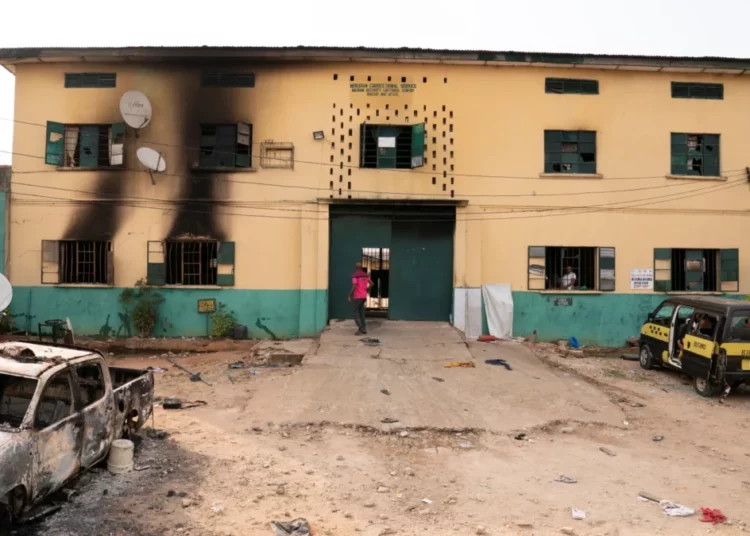Nigeria’s correctional system is indeed in crisis. In just nine years, the country has witnessed no fewer than 19 confirmed jailbreaks, with over 7,200 inmates escaping custody—many never to be seen again.
What was once a trickle of isolated incidents has turned into a troubling surge, with attacks becoming bolder, more frequent, and disturbingly easy.
The most recent jailbreak occurred just yesterday in Keffi, Nasarawa State, where inmates reportedly overpowered guards during an internal disturbance, leading to yet another embarrassing collapse of prison security.
Recall that in a brazen security breach that sent shockwaves through Nigeria’s correctional system, sixteen (16) inmates escaped from the Medium Security Custodial Centre, Keffi, in the early hours of Tuesday.
LEADERSHIP gathered that the well-coordinated attack saw prisoners overpower guards, injuring five correctional officers, two of whom were in critical condition and receiving treatment at a government hospital.
The Nigerian Correctional Service (NCoS) confirmed the incident in an official statement signed by its Public Relations Officer, Abubakar Umar.
Umar revealed that while seven of the escaped inmates had been recaptured, a manhunt was underway for the remaining nine.
According to the statement, the Controller General of Corrections, Sylvester Ndidi Nwakuche, who undertook an on-the-spot assessment of the scene, ordered an immediate investigation into the incident.
He assured the public that no staff member would be shielded if found complicit in the escape, emphasising that accountability would be pursued to the fullest extent.
The statement partly reads:
“This is a grave situation, and we are treating it with the utmost urgency. The safety of Nigerians is our priority,” Nwakuche stated during his visit.
“The Service has launched a nationwide operation in collaboration with other security agencies to recapture the remaining escapees.
“Meanwhile, members of the public are urged to stay calm but alert, and to report any suspicious activities or individuals to the nearest security outpost,” the statement added.
Security experts, however, said that while preliminary findings were still being compiled, this latest breach raised fresh concerns about the vulnerability of correctional facilities across the country.
This is as the NCoS reaffirmed its commitment to public safety and promised swift reforms to prevent a recurrence.
The Service called on anyone with useful information to contact local law enforcement immediately.
Though details remain sketchy, officials confirm that several prisoners fled, compounding fears that Nigeria’s custodial centres are now soft targets for criminals, insurgents, and even the weather.
LEADERSHIP reports that this marks the third jailbreak recorded in 2025. The first happened on 24 March at the Koton Karfe Medium Security Custodial Centre in Kogi State, where 12 inmates escaped by tampering with padlocks. Only six of them were recaptured, while one brave officer lost his life in the chaos. That two prisons have already been breached within the first eight months of the year is no longer shocking—it is now an expectation.
Recall that in May, another bizarre but revealing incident unfolded in Osun State. Torrential rainfall compromised the perimeter fence at the Ilesa Custodial Centre, enabling seven inmates to slip away under the cover of weather and poor infrastructure.
One of them, Kabiru Oyedun, was later tracked to Lagos and rearrested. The remaining six are still at large. It is a sobering reminder that in Nigeria, it is not always guns and bombs that break prison walls; sometimes, it’s just the rain.
While the public grapples with the drama of these recent escapes, the systemic rot goes much deeper. Nigeria’s prisons are bursting at the seams.
Built for far fewer inmates, many now operate at over 200 per cent capacity. Investigations reveal that more than 70 per cent of inmates are still awaiting trial, clogging cells with individuals who, legally speaking, have not been proven guilty.
This prolonged pre-trial detention system not only violates rights but also builds tension, desperation, and volatility within prison walls.
These conditions have set the stage for over a decade of high-profile and deadly jailbreaks.
The spiral arguably began in 2010, when militants believed to be Boko Haram operatives stormed Bauchi prison and freed 721 inmates. Only a few were ever recaptured. In 2013, gunmen attacked prisons in Sagamu and Akure, Ogun and Ondo states respectively, setting loose 195 inmates.
The following year, 2014, brought an alarming chain of jailbreaks across Kogi, Ekiti, and Niger states, where coordinated assaults freed a combined total of 755 inmates. In Ekiti, one officer and more than 20 security dogs were killed in what became one of the bloodiest jailbreaks recorded at the time.
The 2020 #EndSARS protests added a new twist to Nigeria’s jailbreak crisis. In Benin City, Edo State, angry mobs stormed two correctional facilities, freeing nearly 2,000 inmates in broad daylight.
A year later, in 2021, gunmen armed with explosives attacked the prison in Owerri, Imo State, and 1,844 inmates vanished into the streets. Only a fraction were recaptured. By 2022, the danger had reached the capital. The Kuje Medium Security Prison in Abuja was brazenly attacked by Islamist militants believed to be linked to ISWAP. Explosives tore through the compound, and 879 inmates, including high-profile Boko Haram suspects, escaped.
Just 443 were reportedly rearrested. In the same year, minor yet troubling incidents were recorded in Delta and Kwara states, where three inmates each escaped under unusual circumstances, further demonstrating how widespread and varied the crisis had become.
In 2024, it was Niger State’s turn. At the Suleja Correctional Centre, severe rainfall caused the prison walls to collapse, and 119 inmates escaped into the night. Only 10 were recaptured, underscoring once again the fragility of Nigeria’s prison infrastructure in the face of even natural challenges.
Despite repeated alarms and policy promises, the government has failed to act decisively. The Correctional Service has remained underfunded and overstretched. Many facilities still rely on manual records, lacking the digitised systems that could flag or trace escapees.
While it is no longer news that most prison facilities have no surveillance cameras, most perimeter walls are cracked, guard towers unmanned, and response times painfully slow.
LEADERSHIP recalls that prior to the Kuje prison attack, the facility was flagged by the Army months earlier for having no CCTV and weak fences. The warnings went unheeded.
Experts say the real issue lies beyond just fences and padlocks. According to Mr Innocent Utum, a retired senior prison officer, until Nigeria enrols all inmates in a centralised biometric database tied to the National Identification Number (NIN), the country will remain blind in its search for escapees.
He also emphasised the urgent need for prison decongestion, automation of records, improved funding, and a legislative review of pre-trial detention laws.
“Until inmates are mandatorily enrolled in national ID systems, and our prisons receive the technology and manpower to secure them, we’ll keep repeating this cycle,” said a senior correctional officer in Abuja, speaking on condition of anonymity.
Spotlighting the string of jailbreaks from 2010 to date: Kogi, Osun, and Kuje prisons — but a closer examination reveals critical inconsistencies.
Bauchi (2010)
The first major alarm rang in Bauchi, where militants believed to be Boko Haram operatives stormed the prison and freed 721 inmates, marking one of the earliest mass prison breaks in Nigeria’s recent history.
Ogun and Ondo (2013)
In 2013, armed men attacked Sagamu Prison in Ogun, freeing 20 inmates. Months later, 175 prisoners escaped from the federal prison in Akure, Ondo State. Only 54 were recaptured, leaving over 120 at large.
Kogi, Ekiti, and Niger (2014)
A string of coordinated jailbreaks hit central Nigeria. In Kogi’s Koton Karfe prison, a militant raid freed 144 inmates. Ekiti State’s facility was stormed by gunmen who helped 341 inmates escape. Later that year, 270 inmates escaped in Minna, Niger State, after a daring armed assault. Most disturbingly, a correctional officer and over 20 dogs were killed in Ekiti.
Benin, Edo (2020)
In what became the most chaotic incident tied to civil unrest, #EndSARS protests in October 2020 led to the storming of two prisons in Benin City. The outcome: 1,993 inmates broke free in broad daylight, aided by large crowds.
Owerri, Imo (2021)
Militants suspected to be members of the Eastern Security Network (ESN) or IPOB used explosives to raze the prison in Owerri, freeing 1,844 inmates in one of the most daring raids in Nigerian history.
Kuje, FCT (2022)
Nigeria’s capital was not spared. Kuje Prison was attacked by ISWAP terrorists, freeing 879 inmates, including several Boko Haram members. Only about 443 were rearrested in the weeks that followed.
Delta and Kwara (2022)
Unrelated yet alarming, three inmates escaped from Delta’s Agbor prison during a storm, while another three escaped under mysterious circumstances in Kwara.
Hidden Triggers:
Many jailbreaks are traced not only to external attacks but also to internal failures: overcrowding, delayed trials, and underfunded facilities. Despite being called “correctional centres,” many prisons are structurally unfit and hold far more inmates than they were built to accommodate, some exceeding their capacities by over 200 per cent.
LEADERSHIP reports that up to 70 per cent of inmates in Nigeria are awaiting trial, clogging the system and exposing facilities to tension and unrest. Justice is delayed, and in some cases, permanently derailed.
The 2025 Surge:
Osun, Nasarawa in the Spotlight:
Just this year, two jailbreaks have rocked Nigeria in rapid succession:
Osun State (2025)
Though details remain murky, authorities of the Correctional Service confirmed that an internal riot triggered an escape attempt.
Koton Karfe, Kogi (March 2025) –
Twelve inmates fled after allegedly tampering with padlocks during a security lapse. Only six were recaptured. One officer lost his life during the incident.
These recent incidents reaffirm long-standing concerns: poor staffing, corruption, and the inability to secure even medium-security facilities.
While the Nigerian Correctional Service routinely announces recaptures, thousands remain missing. The 2021 Owerri escapees are still being tracked. The Kuje attackers, who mainly included high-risk insurgents, vanished into the population. Many escapees from Edo and Kogi are believed to have reintegrated into criminal networks.
Without modern tracking systems, biometric records, or mandatory National Identification Number (NIN) enrolments, efforts to trace these fugitives are often futile.
Correctional experts and human rights advocates have called for urgent prison decongestion. Mr Innocent Utum, a retired senior prison officer, explained that automation and digitisation of inmate records is no longer optional but essential, arguing that many facilities still rely on paper files and manual logs that are easily manipulated or destroyed during a crisis.
In addition to digitisation, he called for increased funding for perimeter security, including modern surveillance systems, reinforced walls, and trained personnel capable of managing both routine operations and emergencies.
Perhaps most critically, he pushed for a legislative review of pre-trial detention practices, noting that the overwhelming number of inmates are legally innocent but kept behind bars due to prolonged delays in Nigeria’s judicial system—a bottleneck that contributes to congestion and unrest.
LEADERSHIP gathered from an insider who pleaded not to be named that escaped inmates recaptured are as follows:
2010 Bauchi: 721 escapees
2013 Ogun/Ondo: 195 escapees (about 60 recaptured)
2014 Kogi/Ekiti/Niger: 755 escapees (about 200 recaptured)
2020 Edo: 1,993 escapees (minimal recaptures)
2021 Owerri: 1,844 escapees (about 200 recaptured)
2022 Abuja, Delta, Kwara: 885 escapees (about 450 recaptured)
2024 Niger (Suleja): 119 escapees (10 recaptured)
2025 Kogi/Osun/Nasarawa: 18 escapees
This document estimates total escapees (from 2010 to 2025) to be over 7,000, while those recaptured are roughly between 1,000 and 1,500.





